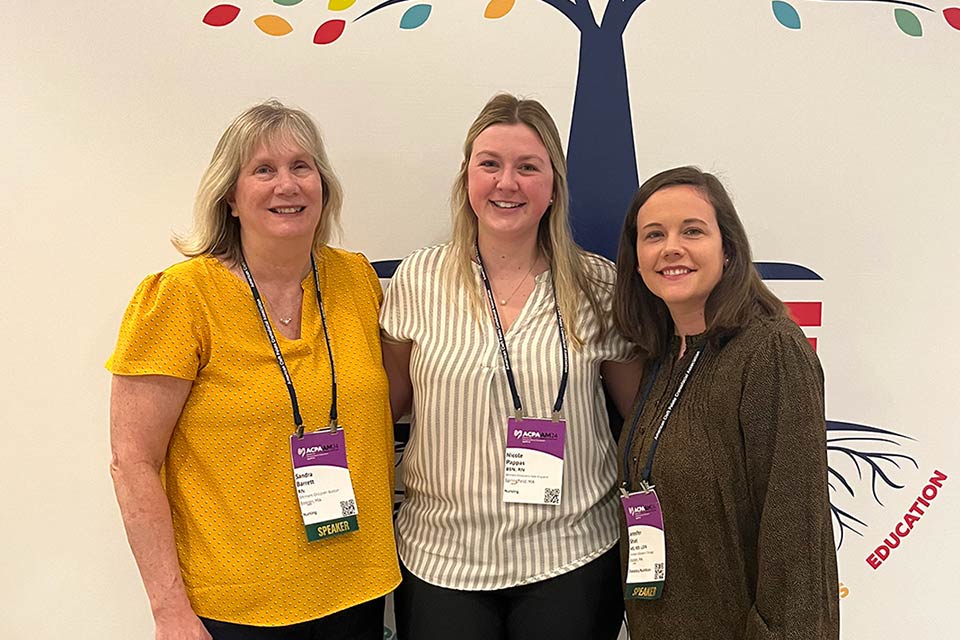Shriners Children’s New England Shares Speech and Language Development Strategies

Shriners Children’s New England speech-language pathologist Sarah Ingraham recommends that parents create consistent communication opportunities at home to help promote language development.
All parents look forward to the milestones of their baby’s first year, wondering when the big moments might happen, including the sound of their first words. Worry can quickly set in, however, if parents believe that their child’s speech development isn’t on track. Shriners Children’s New England speech-language pathologist Sarah Ingraham, MA, CCC-SLP, educates parents about the benchmarks to look for in their child’s first year, and how they can help promote language development at home.
According to Sarah, babies should be communicating in many ways well before they speak their first words. “Babies typically begin smiling at parents by just a few months old, and start cooing and laughing very early as well,” she explained. “Prior to a year, we would expect a child to be looking for sounds they hear in their environment, looking at their parent’s face when they are speaking to them, and reacting to loud sounds. Early gestures such as clapping and waving also develop during the first year.” These behaviors show that babies are learning how to communicate with others, and help create a foundation for more advanced communication skills.
Parents can help their child build language skills by modeling sounds and gestures. Sarah recommends that parents engage in fun and playful verbal interactions and exchanges, and speak slowly and clearly while their child is looking at their face and mouth. Similarly, parents can help their child to wave "hi" and "bye" to people, toys, and other items while saying the words as well. For example, “Hi da-da,” or “Bye-bye blue car.”
As babies become more vocal, babbling with consonant sounds such as ma-ma-ma or ba-ba-ba, is also expected. “By age 1, it is expected that a child will form at least one to three consistent, independent, meaningful word forms,” said Sarah. “They may not be real words, but should be said the same way with the same meaning each time. For example, ‘pa-pa’ for pacifier, ‘ba-ba’ for bottle or ‘wa-wa’ for water.”
Language development strategies can easily be woven into everyday routines and activities. When parents read to their children, pointing to items in books and repeating the words of those items helps to build vocabulary. Talking about daily activities also reinforces language use. For instance, when it’s time to get dressed, a parent can tell their child: “Here are your shoes. Let’s put them on your feet.”

Speech therapy sessions at Shriners Children’s New England typically occur once a week for at least 4-8 weeks, but each case is unique.
Another important benchmark for young children is the ability to follow a simple, one-step direction, such as “stop,” or “come here.” Sarah recommends that parents consider a speech evaluation if they are noticing that their child is not able to follow one-step directions, or doesn’t use at least one consistent word form by their first birthday. If a child isn’t making varied sounds like laughing, crying, cooing or babbling at any point in their first year, or doesn’t often smile or imitate gestures, parents may want to seek speech therapy services. According to Sarah, “It never hurts to schedule an evaluation.”
Communication with their child’s pediatrician is essential if parents have concerns, to help rule out other potential issues such as hearing, or a neurological or developmental condition. A pediatrician’s referral is required in order for a child to receive a speech evaluation at Shriners Children’s New England. “I ask parents why they are here, what has been happening at home, and what their goals are,” said Sarah. “It empowers them to participate in a plan for improvement.”
Speech therapy sessions at Shriners Children’s New England typically occur once a week for at least 4-8 weeks, but each case is unique. At the end of each session, Sarah provides parents with simple exercises to try at home. For instance, repetition is a proven strategy for building language. “Something as easy as saying a word 5-7 times in a conversation can promote language understanding and use,” said Sarah. “Frequently singing nursery rhymes paired with gestures also really helps. Parents leave with tools like these to continue making progress.”
While paying attention to developmental benchmarks is important, Sarah also recommends that parents focus on creating consistent communication opportunities. “Each kid is so different, and there is such a range for what is considered typical,” she said. “It’s important to meet kids and families where they are, and help them take the next steps to feel successful and meet their goals.”
Keep In Touch
Join our mailing list to stay up to date on everything that's happening at Shriners Children's.



